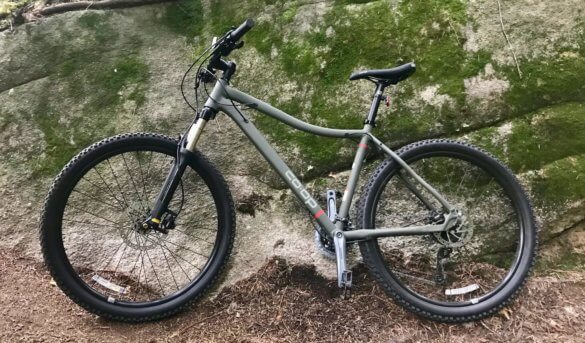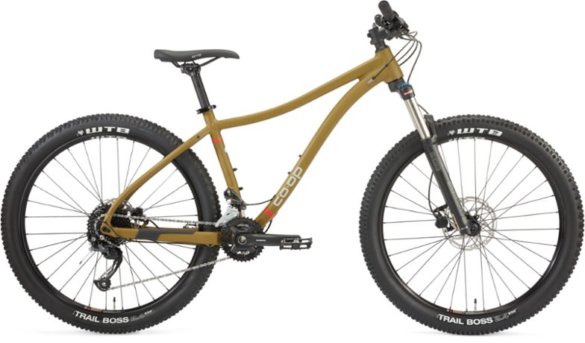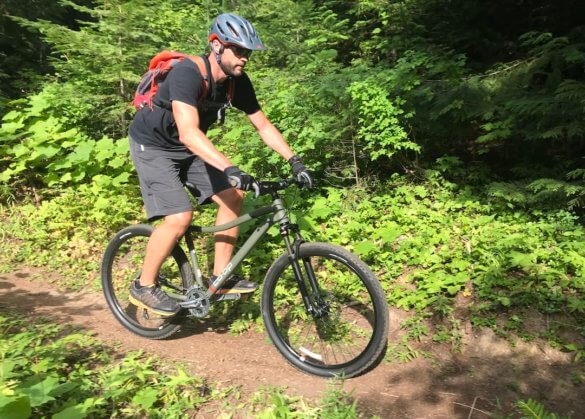The REI Co-op Cycles DRT 1.2 is aimed at recreational mountain bikers who want a solid bike at an affordable price point. The DRT 1.2 is a fantastic value for beginners and the bike itself is far more capable than what most intermediate riders are capable of.
To get us a closer look, REI set up Man Makes Fire with a review unit. This is what we learned:
REI Co-op Cycles DRT 1.2 Review
Let’s say this first: The REI Co-op Cycles DRT 1.2 can handle more than what I can dish out. And that’s the way I like it with most of my gear. I’m a typical competent outdoor adventurer who does a lot of different things over multiple seasons. I have many hobbies, not just a few, and I need to spread my gear budget over backpacking, fly fishing, camping, hiking, rafting, kayaking, SUPing, skiing, hunting, and more.

Still, I have buddies who are great bikers who ride expensive, full-suspension carbon-fiber bikes. All I really need is a thoroughly decent bike that will let me ride some single track and, first and foremost, survive, and second, have fun.
The DRT 1.2 easily delivers what I need, and if you’re reading this review, it probably will for you, too.
Heads-up Alert!
After a difficult year last year, many bikes are still out of stock all over the U.S. Because many bikes share components, the supply chains are still in flux. If you’re interested in the DRT 1.2, act fast before you lose the chance to buy a well-priced mountain bike at all.
Seriously, check now to see if the REI Co-op Cycles DRT 1.2 is still in stock in your size!
Meanwhile, if you’re not sure about your size, check out REI’s handy new How to Fit a Bike & Get the Right Size guide — and then buy the bike before it’s gone again.
Designed for Recreational Mountain Bikers
The REI Co-op Cycles DRT 1.2 is best suited for recreational mountain bikers who want to be able to make it through some difficult single track at modest speeds. And climb some tougher hills. And cruise some gravel trails, mile-long tunnels, and high train trestles like those on the Hiawatha Trail in Idaho. And ride with kids and family down bike paths and through the safer parts of town. I’m only half joking about this last part.

The REI Co-op Cycles DRT 1.2 is a do-it-all mountain bike that most people can push beyond their skill levels.
I can see myself riding the DRT 1.2 for a couple years before I gain enough skill — and time on the trail — to justify a more expensive ride.
Which follows our three basic rules for all gear at Man Makes Fire:
- Buy decent, safe and solid gear you can afford.
- Use the gear, improve your skills, and learn.
- If you become a fanatic, you will have gained the skill and knowledge to upgrade to the very best gear for the type of activity you personally enjoy most.
Simple but effective. The REI Co-op Cycles DRT 1.2 fits the kind of gear we can get behind.
Shipping Alert: REI will now ship bikes directly to your home! This is a huge new benefit. Some assembly is required, of course, but it’s not hard. If you’re not sure about the size of bike to order, REI has created a handy new How to Fit a Bike & Get the Right Size guide.
Go straight to the new 2021 DRT 1.2 now . . . or shop all ‘Mountain Bikes’ at REI to see which models can be shipped to your home.
REI Co-op Cycles: Why go with REI?
REI has sold bikes for years, of course, which makes sense for its outdoor enthusiast customer/member base. As more customers look to the web first for buying decisions, especially for multi-hundred dollar gear purchases, REI is combining online decision making and online buying with flexibility for you. You can buy online and then pick up a bike in person or you can buy online and have the bike shipped to your home. So cool.
Meanwhile, back to the REI-branded bikes. Most bike manufacturers design their own frames and geometries. They then use components made by specialized manufacturers to kit them out. So bikes from different manufacturers might use the same forks, derailleurs, cranksets, wheels, chains, seat posts, and tires.
The mix and match is sometimes a bike company’s secret sauce to gaining the best price-to-value and sometimes it’s just compromises. One company might spend more on the front suspension while another will put more investment into the drivetrain or the frame itself to create a bike that is perfect for a niche or price point.
This is a long way to say that REI Co-op Cycles seem to be staying true to how we see most REI gear: Excellent price-to-value ratios. You might not get the very lightest gear, but you’ll get lightweight durable gear that will perform beyond its price point. Down sleeping bags? Check. Ultralight backpacking tents? Check. Down jackets? Check. Insulated backpacking air mattresses? Check. You get the point.
REI Cycles seems to control costs by designing and using its own branded frames (as expected) along with REI seat posts, handlebars, rims, stems, and pedals.
Most of the remaining components are produced by specialist manufacturers.
The end result is that the DRT 1.2 is a capable bike with more than a fair price-to-value ratio.
Updates for 2021

REI has updated and refined its DRT 1.2 for 2021. The overall quality of components has remained similar, but there are a few interesting tweaks. (If you want to compare for yourself, here’s a link to the previous version.)
The most notable change is to a 2 x 9 drive train that now delivers 18 gears. (The previous version used a 3 x 9 drive train that offered 27 gears.) What gives? Actually, this is a nice upgrade even though you end up with fewer gears. The simpler drive train won’t need as much adjustment, tuning, and weighs less. More experienced riders don’t need 27 gears and prefer to keep things simple and tight. In fact, most hardcore mountain bikers ride with single ring cranks, which deliver more ground clearance and require less maintenance. For the DRT 1.2, the new crankset is a step in the right direction for a bike in this price range and for the riders who likely still want more gear options.
The new frame now more closely resembles the aluminum frame on the DRT 2.2, and it includes several tweaks including better internal cable routing. Some of the geometry has evolved for more versatility. The seat tube angle is steeper, which tends to make a mountain bike better for climbing. The head angle is a bit increased, which makes it a bit more stable downhill. The increased reach makes the cockpit roomier and more comfortable.
One key feature that REI didn’t change is the generous front fork travel.
120mm of Fork Travel
The REI DRT 1.2 is a hardtail mountain bike, which means it does not have a rear suspension system. The front forks do. Better yet, the front SR Suntour XCR dual piston suspension has a whopping 120mm of fork travel. Most competitors in this price range have 100mm or less of fork travel.
As you get faster and more aggressive and hit bigger bumps, you’ll appreciate the 120mm fork travel.
The Shimano 2 x 9 drivetrain gives you 18 gears to choose from. As I mentioned above, advanced and expert riders might prefer fewer gears in a lighter and simpler drive train — but these setups are still expensive. The 2 x 9 drivetrain is a more affordable option that serves two purposes: First, you’ll have plenty of low gears to help you climb, which you’ll need if you are following more experienced riders who are in presumably better riding shape. Second, you’ll have plenty of gears to let you truly cruise on pavement and simple trails, too.
The frame is aluminum, which is lightweight and strong. Should be able to handle most abuse from typical recreational and intermediate riders. I’m a relatively large, 225-pound rider and I’m confident in the frame for everything but big jumps and hard landings (which I’m not going to do anyway).
The wheels are 27.5 inches, which are bigger than old-school 26-inchers and smaller than the 29-inchers that took over the mountain biking world a few years ago. For most people, 27.5 seems to offer the best blend of start and stop speed with agility.
The 32 lbs. 4.7 oz weight is competitive with bikes in this class. A couple thousand dollars will drop a few pounds, of course, but don’t let hard-core bikers get you worried about weight. (At least not until you’re a mountain biking fanatic.) It would be easier for most guys to lose 10 pounds of their own bodyweight than it would be to shell out $5,000+ for a bike. Some guys spend more on their bikes than their vehicles. I’m not judging here, just saying that you shouldn’t get too caught up in the specs. My first-aid kit weighs more than a pound and it goes most places I go. To each their own.
REI Co-op DRT 1.1 vs 1.2 vs 2.2
If you’re reading this review, you’re probably a bit stuck on your next mountain bike purchase. You probably like the $550 price point of entry-level mountain bikes, but you suspect you would appreciate a bit more performance. You also might be concerned about overspending on something you may or may not need or love. I get it. I’ve been there many times for all sorts of gear. Here is what you need to know to make your REI DRT decision.
First, the DRT 1.1 is a bit heavier and uses components that are a notch or two down in overall quality compared to the DRT 1.2. Still, the DRT 1.1 is more bike than most beginning riders will need. It’s perfect for casual single-track rides and chasing kids over payment, down family trails and commuting to campus. Again, it’s a do-it-all mountain bike for those who want something that is trail-capable first and foremost, and pavement capable next. To learn more, ready my full REI Co-op Cycles DRT 1.1 review.

The DRT 1.2 hits a sweet spot in value for those who are more aspirational in their riding interests. If you think you’ll want to ride tougher trails or hang with your buddies, the DRT 1.2 is likely worth the extra investment. You get 120mm of fork travel to help suck up the bumps, better components, and a frame that has internal cable routing that’s ready for a dropper post upgrade. What’s a dropper post? A dropper post lets you raise and lower your seat post while riding. A control on your handle bar lets you lower your seat height while going down steep hills. You can instantly raise it to your preferred height on even ground or when you need to climb. They are cool if you ride a lot of steep up and down trails.
In addition, the rims on the DRT 1.2 are tubeless-ready. If you have the skill to change out an inner tube, you can upgrade to tubeless tires on your own at home. It will make your bike lighter and feel more nimble. (As you get better, you will likely start riding tubeless.)
The DRT 2.2 improves all the components. You get a more modern drivetrain, a much better suspension fork, and the cool aforementioned dropper seat post. If it’s in your budget, nab it.
REI offers higher-end mountain bikes, of course, all of which are worth it if you have a big budget and plan to spend a lot of time riding.
On the Trail
The REI Co-op DRT 1.2 is solid and nimble. The hydraulic brakes offer plenty of stopping power but are also easy to finesse for beginners.
The front suspension — using the settings made by REI’s mechanics — was able to handle some big roots and rocks. A couple times I hit things harder than I intended and the front suspension kept me on the trail.
Shifting is reasonably crisp.

I’ve ridden some higher-end, carbon-fiber full suspension bikes and they are no doubt lighter and crisper and deliver smoother rides over rough terrain. In fact, on one on-trail test, I jumped on a buddy’s Santa Cruz. For a guy with my skills, it was smoother but not radically more fun. The key takeaway was that I was able to fly down the trail at a much faster speed . . . which was not good. Launching off trail into blowdown trees with shard-like limbs or crashing into a large cedar trunk would ruin anyone’s day. Basically, the full-suspension delivered less feedback and gave me a false sense of confidence. Luckily, I realized that my high-speed trail navigation skills were well below the bike’s abilities and used the brakes.
From a learning perspective, the hardtail DRT 1.2 reminds you that the trail is rough when it is rough — and rolls smooth when it’s smooth. To me, this is all part of the learning curve. If there are any upgrades needed in my near future, it’ll be a dropper seat post and maybe some sweet Five Ten riding shoes.
The Verdict
All-in-all, the REI Co-op Cycles DRT 1.2 offers a full step up from entry-level mountain bikes that aim for the $500 entry price point. In the under $1,000 class, the REI Co-op DRT 1.2 is a great value, and an outstanding value if you find it on sale.
If you’re looking for an affordable mountain bike that’s capable of intermediate trails — and some rougher trails if you’re willing to go slower than your hard-core buddies — the REI Co-op Cycles DRT 1.2 is tough to beat. Highly recommended.








